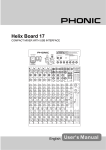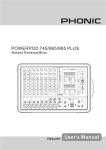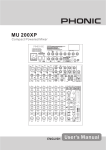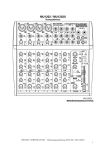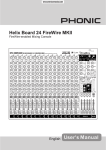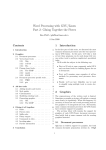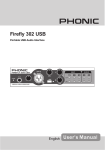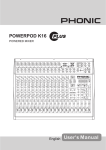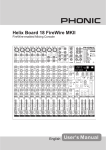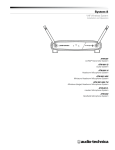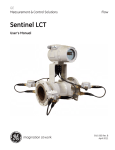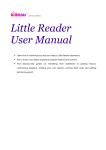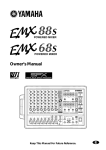Download MU 1202 / 1202X - New
Transcript
MU 1202 / 1202X Compact Mixers V1.5 2004/10/13 IMPORTANT SAFETY INSTRUCTIONS 1. Read these instructions before operating this apparatus. 2. Keep these instructions for future reference. 3. Heed all warnings to ensure safe operation. 4. Follow all instructions provided in this document. 5. Do not use this apparatus near water or in locations where condensation may occur. 6. Clean only with dry cloth. Do not use aerosol or liquid cleaners. Unplug this apparatus before cleaning. 7. Do not block any of the ventilation openings. Install in accordance with the manufacturer’s instructions. 8. Do not install near any heat sources such as radiators, heat registers, stoves, or other apparatus (including amplifiers) that produce heat. 9. Do not defeat the safety purpose of the polarized or grounding-type plug. A polarized plug has two blades with one wider than the other. A grounding type plug has two blades and a third grounding prong. The wide blade or the third prong is provided for your safety. If the provided plug does not fit into your outlet, consult an electrician for replacement of the obsolete outlet. 10. Protect the power cord from being walked on or pinched particularly at plug, convenience receptacles, and the point where they exit from the apparatus. 11. Only use attachments/accessories specified by the manufacturer. 12. Use only with a cart, stand, tripod, bracket, or table specified by the manufacturer, or sold with the apparatus. When a cart is used, use caution when moving the cart/ apparatus combination to avoid injury from tip-over. 13. Unplug this apparatus during lighting storms or when unused for long periods of time. 14. Refer all servicing to qualified service personnel. Servicing is required when the apparatus has been damaged in any way, such as power-supply cord or plug is damaged, liquid has been spilled or objects have fallen into the apparatus, the apparatus has been exposed to rain or moisture, does not operate normally, or has been dropped. CAUTION: TO REDUCE THE RISK OF ELECTRIC SHOCK, DO NOT REMOVE COVER (OR BACK) NO USER SERVICEABLE PARTS INSIDE REFER SERVICING TO QUALIFIED PERSONNEL The lightning flash with arrowhead symbol, within an equilateral triangle, is intended to alert the user to the presence of uninsulated “dangerous voltage” within the product’s enclosure that may be of sufficient magnitude to constitute a risk of electric shock to persons. The exclamation point within an equilateral triangle is intended to alert the user to the presence of important operating and maintenance (servicing) instructions in the literature accompanying the appliance. WARNING: To reduce the risk of fire or electric shock, do not expose this apparatus to rain or moisture. CAUTION: Use of controls or adjustments or performance of procedures other than those specified may result in hazardous radiation exposure. TABLE OF CONTENTS page INTRODUCTION ...................................................................................................................4 FEATURES............................................................................................................................4 GETTING STARTED.............................................................................................................5 CHANNEL SETUP ................................................................................................................5 MAKING CONNECTIONS.....................................................................................................6 CONTROLS AND SETTINGS...............................................................................................8 APPLICATION ..................................................................................................................... 12 DIGITAL EFFECT TABLE.................................................................................................... 13 DIMENSIONS...................................................................................................................... 14 BLOCK DIAGRAMS ............................................................................................................ 16 SPECIFICATIONS ............................................................................................................... 18 INTRODUCTION FEATURES Thank you for choosing one of Phonic’s many quality compact mixers. The MU 1202 and 1202X Compact Mixers – designed by the ingenious engineers that have created a variety of mixers fantastic in style and performance in the past – display similar proficiency that previous Phonic products have shown; with more than a few refinements, of course. The entire MU series features full gain ranges, amazingly low distortion levels, and incredibly wide dynamic ranges, just showing the dominance these small machines will have in the mixing World. MU1202 and MU1202X l Audiophile-Quality & ultra low noise l 4 mono mic/line channels l 2 stereo channels and 2 stereo aux returns l 2 Aux sends per channel l 75Hz low-cut filter on mono channel l 3-band EQ on each channel l +48V phantom power on mic channels l Control room/Phones source matrix l Stereo AUX send 1 cue for monitoring individual channel l Handy mini-stereo and RCA-type inputs and outputs, record output with independent trim control for recording level matching l High-volume headphone output l Balanced TRS outputs l Optional rack-mounting kit We know how eager you are to get started – wanting to get the mixer out and hook it all up is probably your number one priority right now – but before you do, we strongly urge you to take a look through this manual. Inside, you will find important facts and figures on the set up, use and applications of your brand new mixer. If you do happen to be one of the many people who flatly refuse to read user manuals, then we just urge you to at least glance at the Instant Setup section. After glancing at or reading through the manual (we applaud you if you do read the entire manual), please store it in a place that is easy for you to find, because chances are there’s something you missed the first time around. Page 4 MU1202X additions: l Inserts on mic channels l 24-bit digital stereo multi-effect processor with 16 programs plus one main parameter control, tap control and foot switches l Extra ALT 3-4 Output l Master AUX section with EFX to Monitor MU 1202/1202X USER’S MANUAL PHONIC CORPORATION GETTING STARTED CHANNEL SETUP 1. Ensure all power is turned off on your mixer. To totally ensure this, the AC cable should not be connected to the unit. 1. To ensure the correct audio level of the input channel is selected, each of the level input controls of the Mixer should be turned counterclockwise or down as far as they will go. 2. All faders and level controls should be set at the lowest level and all channels muted to ensure no sound is inadvertently sent through the outputs when the device is switched on. All levels can be altered to acceptable degrees after the device is turned on using the channel setup instructions. 3. Plug any necessary equipment into the device’s various outputs. This could include amplifiers and speakers, monitors, signal processors, and/or recording devices. 4. Plug the supplied AC cable into the AC inlet on the back of the device and then into a power outlet of a suitable voltage. 5. Turn the power switch on and follow the channel setup instructions to get the most out of your equipment. 2. No input other than the one being set should have any device plugged in. This will ensure the purest signal is used when setting channels. 3. Set the level and AUX 1 controls of the channel you are setting to the 0 dB mark. Also set the Main L-R fader to the 0 dB mark. 4. Press down the AUX 1 button on the control room source section, allowing the level meter to display the level of the channel being set. 5. Ensure the channel has a signal sent to it similar to the signal that will be sent when in common use. For example, if the channel is using a microphone, then you should speak or sing at the same level the performer normally would during a performance; if a guitar is plugged into the channel, then the guitar should also be strummed as it normally would be (and so on). This ensures levels are completely accurate and avoids having to reset them later. 6. Set the gain so the Level Meter indicates the audio level is around 0 dB. 7. This channel is now ready to be used; you can stop making the audio signal. 8. You can repeat the same process for other channels. Or not, it’s your call. PHONIC CORPORATION MU 1202/1202X USER’S MANUAL Page 5 MU1202 MAKING CONNECTIONS Inputs and Outputs 1. XLR Microphone Jacks These jacks accept typical 3-pin XLR inputs for balanced and unbalanced signals. They can be used in conjunction with microphones – such as professional condenser, dynamic or ribbon microphones - with standard XLR male connectors, and feature low noise preamplifiers, serving for crystal clear sound replication. The MU1202 and MU1202X mixers feature four standard XLR microphone inputs for your convenience. NB. When these inputs are used with condenser microphones, the Phantom Power should be activated. However, when Phantom Power button is engaged, single ended (unbalanced) microphones and instruments should not be used on the Mic inputs. 2. Line Inputs This input accepts typical 1/4” TRS or TS inputs, for balanced or unbalanced signals. There are various numbers of these inputs depending which mixer you are using. They can be used in conjunction with various line level devices, such as keyboards, drum machines, electric guitars, and a variety of other electric instruments. Page 6 3. Stereo Channels The MU1202 and MU1202X mixer features a couple of stereo channels, thrown in for maximum flexibility. Each of these stereo channels features two 1/4” TRS phone jacks, for the addition of various line level input devices, such as electronic keyboards, guitars and external signal processors or mixers. These Stereo Channels can also be used as Mono channels, where the signal from any 1/4" phone jack plugged into the Left stereo input will cause the signal to be duplicated to the Right input due to the miracle of jack normalizing. This does not work in reverse, however. 4. Stereo AUX Return These 1/4” TS inputs are for the return of audio to the MU1202 and MU1202X mixer, processed by an external signal processor. If really needed, they can also be used as additional stereo inputs, with a level control located on the face of the mixer. The Stereo AUX Return can also accept Mono signals, where plugging the 1/4" phone jack of any device into the Left input will cause the signal to be duplicated to the Right input also. This does not work in reverse, however. MU 1202/1202X USER’S MANUAL PHONIC CORPORATION MU1202X 5. AUX / Effects Send These 1/4” TS outputs may be used to connect to an external digital effect processor, or even to an amplifier and speakers (depending on your desired settings), to the mixer. 6. Main L and R Outputs These two ports will output the final stereo balanced line level signal sent from the main mixing bus. The primary purpose of these jacks is to send the main output to external devices, which may include power amplifiers (and in-turn, a pair of speakers), other mixers, as well as a wide range of other possible signal processors (Equalizers, Crossovers, etcetera). NB. When sending unbalanced signals from this output, a 1/4" TRS stereo plugs must be used and have the ring-pin disconnected, as to avoid damaging this mixer. 7. Control Room Outputs These two 1/4” Phone Jack outputs feed the signal altered by the CTRL RM / PHONES level control (Or CTRL RM / SUBMIX level control on the MU1202X) on the face of the mixer. This output has extensive use, as it can be used to feed the signal from the mixer to an active monitor, for the monitoring of the audio signal from within 8. Phones This stereo output port is suited for use with headphones, allowing monitoring of the mix. The audio level of this output is controlled using the CTRL RM / PHONES level control (Or CTRL RM / SUBMIX level control on the MU1202X). 9. Record Out These outputs will accommodate RCA cables, able to be fed to a variety of recording devices. Also included is a mini stereo jack for the addition of recording devices such as MD players, and even laptop computers, as well as a Trim control, allowing users to control the output signal level, ensuring total control over recording quality. 10. 2T Return These RCA and mini stereo inputs are used to connect the mixer with external devices, such as tape and CD players, or even Laptop computers, receiving a signal from another source and feeding it to the Main L-R mixing bus. a booth, among other possible uses. PHONIC CORPORATION MU 1202/1202X USER’S MANUAL Page 7 MU1202X CONTROLS AND SETTINGS Rear Panel Rear Panel 11. Foot Switch Jacks (MU 1202X only) 15. Power Switch These ports are for the inclusion of a foot switch, used to remotely adjust properties of the built-in Digital Effect processor, to the mixer. The left jack is used to adjust the tap delay properties, where the right jack is used for turning the effects on and off. This switch is used to turn the mixer on and off. Ensure you turn all level controls down before activating. 12. ALT 3-4 Output (MU 1202X only) The signal sent from these outputs is fed from the ALT 3-4 mixing bus, and can be used in conjunction with a large array of devices, including signal processors, other PA systems, recording devices, and so on. 13. Channel Inserts (MU 1202X only) Located on the rear of the MU1202X, the primary use for these TRS phone jacks is for the addition of external devices, such as dynamic processors or equalizers, to mono input channels 1 through to 4. This will require a Y cord that can send (pre-fader and pre-EQ) and receive signals to and from an external processor. 16. Phantom Power Switch When this switch is in the on position, it activates +48V of phantom power for all microphone inputs, allowing condenser microphones (well, the ones that don’t use batteries) to be used on these channels. Activating Phantom Power will be accompanied by an illuminated LED above the left channel Level Meter. Before turning Phantom Power on, turn all level controls to a minimum to avoid the possibility of a ghastly popping sound from the speakers. The MU1202X's Phantom Power switch is located on the rear of the device, whereas the MU1202's Phantom Power switch is located on the front panel. NB. Phantom Power should be used in conjunction with balanced microphones. When Phantom Power is engaged, single ended (unbalanced) microphones and instruments should not be used on the Mic inputs. Phantom Power will not cause damage to most dynamic microphones, however if unsure, the microphone’s user manual should be consulted. MU1202 14. Power Connector This port is for the addition of a power cable and supply, allowing power to be supplied to the mixer. Please use the external power supply that is included with this mixer only. Page 8 MU 1202/1202X USER’S MANUAL PHONIC CORPORATION 22. AUX 1 (Monitor) Control This control allows the user to send the corresponding signal to the AUX 1 output, which can be used in conjunction with an amplifier and studio or stage monitors, or simply as an auxiliary output for any means required. The control is pre-fader, therefore any changes made to the corresponding channel level control (27) do not affect the AUX 1 send signal. Channel Controls 17. Low Cut Filter (75 Hz) This button, located on channels 1 through to 4, will activate a low-cut / high-pass filter that reduces all frequencies below 75 Hz at 18 dB per Octave, helping to remove any unwanted ground noise or stage rumble. 18. Line / Mic Gain Control This controls the sensitivity of the input signal of the Line/Microphone input. The gain should be adjusted to a level that allows the maximum use of the audio, while still maintaining the quality of the feed. This can be accomplished by adjusting it to a level that will allow the peak indicator occasionally illuminate. All 4 mono channels on the MU1202 and MU1202X feature this control. 19. High Frequency Control This control is used to give a shelving boost or cut of ±15 dB to high frequency (12 kHz) sounds. This will adjust the amount of treble included in the audio of the channel, adding strength and crispness to sounds such as guitars, cymbals, and synthesizers. 20. Middle Frequency Control This control is used to provide a peaking style of boost and cut to the level of middle frequency (2.5 kHz) sounds at a range of ±15 dB. Changing middle frequencies of an audio feed can be rather difficult when used in a professional audio mix, as it is usually more desirable to cut middle frequency sounds rather than boost them, thereby soothing overly harsh vocal and instrument sounds in the audio. 21. Low Frequency Control This control is used to give a shelving boost or cut of ±15 dB to low frequency (80 Hz) sounds. This will adjust the amount of bass included in the audio of the channel, and bring more warmth and punch to drums and bass guitars. PHONIC CORPORATION 23. AUX 2 (Effects) Control This control alters the signal level that is sent to the AUX 2 (or EFX) send output, which can be used in conjunction with external signal processors (this signal of which can be returned to mixer via the AUX return input, or any stereo input channel), or simply as an auxiliary output for any means required. This control is post-fader, therefore any changes made to the corresponding channel level control (27) are also applied to the EFX signal. 24. Pan / Balance Controls This alternates the degree or level of audio that the left and right side of the main mix should receive. On mono channels, this control will adjust the level that the left and right should receive (pan), where as on a stereo channel, adjusting the BAL control will attenuate the left or right audio signals accordingly (balance). 25. Mute / ALT 3-4 (MU1202X Only) This handy little button is basically a typical mute button – effectively stopping any signal received by the channel from being sent to the Main L/R mixing bus – however it does so much more. Pushing this button routes the channel’s signal away from the Main L/R and to its own “Alternative” stereo output, where the signal can be used at will. If you wish to use it to connect an amplifier and speakers, or simply patch it through to an unused input channel, you can easily do so. 26. Peak Indicator This LED indicator will illuminate when the device hits high peaks, 6 dB before overload occurs. It is best to adjust the gain of the channel so that the PEAK indicator lights up on intervals only. This will ensure a greater dynamic range of audio. 27. Level Control This rotary control will alter the signal level that is sent from the corresponding channel to the main mixing bus. MU 1202/1202X USER’S MANUAL Page 9 28. +4 / -10 Switch (MU1202X only) This button, located on both stereo input channels, is used adjust the input sensitivity of the corresponding channels, which will adapt the MU1202X to external devices which may use different operating levels. If the input source is -10 dBV (consumer audio level), it is best to engage the switch, allowing the signal to be heard. The +4 dBu level is suitable for Professional Audio signals, which are considerably higher than the consumer level. However, if you are unsure of the source’s operating level, we suggest leaving the switch disengaged until you test the source’s signal. You can then engage if necessary (if the level of the input signal is obviously too low). Digital Effect Section (MU 1202X only) 29. Digital Effect Display This panel displays the titles of different effects that can be added to your audio signal. When you select the effect number with the Program Control, the corresponding effect is applied automatically. For a list of available effects, please observe the Digital Effect Table. 30. Program Control This control is used to scroll through the various effects shown on the Digital Effect Display. Turning the control will automatically change the effect and apply it to the EFX RTN 2 feed. 31. Parameter Control This will adjust the appropriate one main parameter of the digital effect that is applied to the audio feed. Page 10 32. DSP Effect On and Indicator This button is pushed to turn the corresponding effect panel on or off. When the effect processor is turned on, the corresponding LED illuminates. 33. Peak Indicator This LED indicator will illuminate when the DSP is overdriven and causes distortion. It is best to adjust the AUX 2 / EFX Send fader so as to ensure the PEAK indicator does not light. This will ensure a greater dynamic range for audio. 34. Tap Delay and Indicator When the tap delay effect is selected, this button is used to determine the delay time. By pushing the button several times, the mixer interprets the time between last two pushes and remembers this as the delay time, until the button is pushed again (this is kept, even after the power is turned off). When the tap delay effect is selected, the corresponding LED will flash at the intervals selected. Master Section 35. AUX Stereo Return Controls MU1202: These controls adjust various properties of the ST Rtn signals. The AUX 1 control adjusts the level that is sent to the monitor mixing bus, where as the Level control adjusts the level that is sent to the Main L/R mixing bus. The BAL control will attenuate the left or right audio signals accordingly. MU1202X: These controls adjust the signal level of audio fed through to the AUX Stereo Return inputs, which will be added to the MAIN L-R mix. The AUX Return 2 control also acts as the builtin DSP Effect level control, when no device is plugged into the AUX 2 Return jacks. 36. AUX Stereo Return “to AUX 1” Send Controls These two rotary controls are used to adjust the audio signal received by the AUX Return 1 and 2 jacks, which is sent to the AUX 1 Send output. These act as an "effect to Monitor" control, allowing performers/engineers to hear the signal processed by either external devices or the Internal DSP Effect Engine. MU 1202/1202X USER’S MANUAL PHONIC CORPORATION 37. Control Room Source Buttons Engaging any of these four buttons will enable you to use the signal from any of the corresponding sources to send to the Control Room mixing bus and the LED Level Meter for level monitoring. For instance, pressing 2T Rtn button will allow you to send the 2 Track Return signal to the Control Room Outputs and Level Meter, where as the Main L-R will allow you to use the Main Left/Right signal instead, the AUX 1 allows you to use the AUX 1 signal and the ALT 3-4 allows you to use the addition stereo mix bus signal. You can even use a combination of all these signals, if need be. MU1202X On the MU1202, you can choose to send either the AUX 1 (Stereo), AUX 2, Main or 2T Return signals to the Control Room. 38. Assign To Main Button (MU1202X Only) MU1202 40. 2T Return Control and "to Main" button (MU1202 Only) This control adjusts the signal level received by the 2T Return inputs, that is sent to the Control Room Source section. Using the "to Main" button will do just that: send the 2T Return signal to the Main L-R mixing bus. 41. Record Out Trim Control The MU1202's Record Out Trim Control allows users to set the level of the Rec Out outputs to that which allows clear, quality recording on all recording devices. The MU1202X also features trim control on the Record Out outputs, located by the Rec Out jacks. 42. Main L-R Control This 60mm fader is final level control for the main left and right audio feed, sent to the Main L and R output. When the "Assign To Main" button is engaged, the 2T Return and Alternative 3-4 signals can be selected by using the corresponding buttons, and are, intern, sent to the Main L-R and Control Room mixing buses via the Control Room / Submix control. This can come in handy when you want play a CD during intermission in a live show. If you have the Main L-R or AUX 1 buttons on the Control Room Source section engaged, the corresponding signals will not be sent to the Main L-R by way of this button, nor will their signals be sent to the Control Room or Phones outputs. 43. Level Meter The MU1202 and MU1202X’s stereo 10-segment level meters give an accurate indication of when audio levels from the Control Room Matrix Source reach certain levels. It is suggested for the maximum use of audio to set the various levels controls so that the Peak LEDs flash only occasionally (and perhaps it is better if you ensure the level stays around a pinch below that). 39. Ctrl Rm / Submix Control / Phones This control is used to adjust the audio level of the Control Room feed, which is sent to both the Control Room outputs (for monitoring, acting as side fill or other purposes) and Phones outputs (to be used in conjunction with headphones for monitoring purposes). On the MU1202X it also acts as the "submix" control, which allows the user to adjust the signal selected by the Control Room Source when the Assign to Main button is engaged. PHONIC CORPORATION 44. +48 Indicator The +48 Indicator illuminates whenever the Phantom Power switch is activated. 45. Power Indicator The Power Indicator will light up when the power of the mixer is on; in case you weren’t too sure. 46. AUX 1 and 2 Send Master Controls (MU1202 Only) These controls adjust the final signal level from the AUX 1 (MONI) and AUX 2 (EFX) mixing buses to the corresponding AUX 1 and 2 output jacks. MU 1202/1202X USER’S MANUAL Page 11 APPLICATION There are potentially hundreds of ways to connect instruments and devices to the MU1202 and 1202X Compact Mixers. It is advisable that you explore the functions and find the best setup possible for your needs, which may depend on what instruments you wish to connect, as well as how many external devices you wish to connect and your required monitoring applications. Combining the use of different instruments with the mixer’s special functions (such as digital effect processing, in the case of the MU1202X) will ensure that your audio sounds exactly the way you want it. Page 12 MU 1202/1202X USER’S MANUAL PHONIC CORPORATION DIGITAL EFFECT TABLE Parameter Controllability No Program Name Program Description Parameter Variable Range 1 HALL This reverb simulates a large, expanse setting, such as a concert hall Reverb Time 0.3 sec – 10.0 sec 2 ROOM Creates acoustics similar to those of a small room Reverb Time 0.3 sec – 3.2 sec 3 PLATE Simulates a Plate Reverb device, creating hard sounding Reverberation Reverb Time 0.3 sec – 10.0 sec 4 VOCAL 1 Ideal for Reverb of vocals Reverb Time 0.3 sec – 10.0 sec 5 VOCAL 2 Ideal for Reverb of vocals Reverb Time 0.3 sec – 10.0 sec 6 ECHO 1 Ideal for Echoing vocals Delay Time 0 – 800 ms 7 ECHO 2 Ideal for Echoing vocals Delay Time 0 – 800 ms 8 DELAY 1 Delays the audio signal Delay Time 0 – 800 ms 9 DELAY 2 Delays the audio signal Delay Time 0 – 800 ms 10 EARLY REF. Modifies early reflections, creating a deeper sound or an echo-like effect Room Size 0.1 – 10.0 11 G. REVERB Produces effect by cutting the reverberation Room Size 0.1 – 5.0 12 DOUBLER Creates an effect simulating 2 vocalists Modulation Frequency 0 – 50 13 SYMPHONIC Adds richly layered depth to the sound Depth 0 – 100% 14 FLANGE Adds a sense of pitch to the sound Modulation Frequency 0.05 – 4.00 Hz 15 DISTORTION Used to distort the sound Drive 0 – 100% Feedback Gain 0 – 99% TAP DELAY Allows you to select the delay time by clicking a button twice or by use of a footswitch. The amount of feedback is adjusted using the PARAMETER control. Delay Time 100 ms (600bpm) – 2690 ms (22.3bpm) 16 PHONIC CORPORATION MU 1202/1202X USER’S MANUAL Page 13 DIMENSIONS MU1202 59.8 mm / 2.4 inches 52.8 mm / 2.1 inches 41.0 mm / 1.6 inches Page 14 271.3 mm / 10.7 inches 264.3 mm / 10.4 inches 274.7 mm / 10.8 inches MU 1202/1202X USER’S MANUAL PHONIC CORPORATION MU1202X 86.0 mm / 3.4 inches 245.4 mm / 9.7 inches 81.5 mm / 3.2 inches 66.0 mm / 2.6 inches PHONIC CORPORATION 271.3 mm / 10.7 inches 264.3 mm / 10.4 inches 240.0 mm / 9.4 inches MU 1202/1202X USER’S MANUAL Page 15 75Hz HPF LOW CUT R STEREO RTN1/2 L(MONO) R(6/8) STEREO CHANNEL L(5/7) MONO CHANNEL (1 OF 4) 1 GAIN HIGH 12K HI MID 2.5K MID EQ 80 LO LOW LEVEL BAL. TO AUX1 LEVEL PAN AUX1 AUX1 LEVEL PEAK AUX2 BAL. AUX2 MU1202 BLOCK DIAGRAM TRIM AUX1 MU 1202/1202X USER’S MANUAL AUX1 AUX2 MAIN L/R MAIN FADER AUX2 TO MAIN AUX2 MIX AUX1 MIX MAIN MIX AUX2 AUX1 R AUX1 L MAIN R MAIN L LINE IN MIC IN PH.PWR. 3 Page 16 2 PHANTOM POWER (GLOBAL SWITCH) SOURE MIX 2T RTN CTRLRM PHONES 2T RTN AUX2(EFX) OUT AUX1 OUT MAIN R MAIN L REC OUT R MINI REC OUT REC OUT L PHONES CTRL RM R PEAK +7 +4 +2 0 -2 -4 -7 -10 -20 0dBu=0.775V CTRL RM L 2T RTN R MINI ST. 2T RTN L MU1202 BLOCK DIAGRAM PHONIC CORPORATION PHONIC CORPORATION R(6/8) STEREO CHANNEL L(5/7) 75Hz HPF LOW CUT MU 1202/1202X USER’S MANUAL R AUX RTN2 L R AUX RTN1 L(MONO) +4/-10 MONO CHANNEL (1 OF 4) 1 GAIN MID MID 2.5K EQ 80 LO 80 2.5K TAP DELAY EFFECT ON/OFF LO MID HI 80 2.5K 12K LO MID HI 12K PEAK AUX1 LEVEL AUX1 LEVEL PEAK/MUTE LOW PEAK/MUTE HIGH 12K HI INSERT AUX2 PROGRAM PARAMETER HDA 24BIT DSP ON TO AUX1 TO AUX1 AUX2 MUTE(ALT3/4) TAP DELAY RTN2 RTN1 BAL. PAN MUTE(ALT3/4) ALT MIX AUX2 MIX AUX1 MIX MAIN MIX AUX2 AUX1 R AUX1 L ALT 4 ALT 3 MAIN R MAIN L LINE IN MIC IN 3 PH.PWR. 2 PHANTOM POWER (GLOBAL SWITCH) ALT 3/4 2T RTN 0dBu=0.775V 2T RTN R MINI ST. 2T RTN L CTRLRM SUBMIX PEAK +7 +4 +2 0 -2 -4 -7 -10 -20 ALT4 OUT ALT3 OUT AUX2(EFX) OUT AUX1 OUT MAIN R MAIN L REC OUT R MINI REC OUT REC OUT L SOURE MIX ASSIGN TO MAIN MAIN L/R AUX1 MAIN FADER TRIM PHONES CTRL RM R CTRL RM L MU1202X BLOCK DIAGRAM Page 17 SPECIFICATIONS MU 1202 MU 1202X Total Channels 6 6 Balanced Mono Mic / Line Channel 4 4 Balanced Stereo Line Channel 2 2 2 stereo 2 stereo Mini stereo and stereo RCA Mini stereo and stereo RCA 2 x 1/4” TRS, Bal. 2 x 1/4” TRS, Bal. Inputs Aux Return 2T Input Outputs Main L/R Stereo Alt 3-4 N/A 2 x 1/4” TRS, Bal. Mini stereo and stereo RCA Mini stereo and stereo RCA 2 x 1/4” TS 2 x 1/4” TS Phones 1 1 Channel Strips 6 6 AUX Send 2 2 Rec Out CTRL RM L/R Pan/Balance Control Yes Yes Rotary Rotary N/A 4 Yes Yes Main L/R, 60mm fader Main L/R, 60mm fader 10-segment 10-segment +48V DC +48V DC 20Hz ~ 60KHz +0/-1 dB +0/-1 dB 20Hz ~ 100KHz +0/-3 dB +0/-3 dB <-90 dB <-90 dB -86.5 dBu -86.5 dBu Master @ unity, channel fader @ unity -84 dBu -84 dBu S/N ratio, ref to +4 >90 dB >90 dB <-129.5 dBm <-129.5 dBm Volume Controls Inserts Master Section Phones Level Control Main L/R Level Control Level Meter Phantom Power Supply Frequency Response (Mic input to any output) Crosstalk (1KHz @ 0dBu, 20Hz to 20KHz bandwidth, channel in to main L/R outputs) Channel fader down, other channels at unity Noise (20Hz~20KHz; measured at main output, Channels 1-4 unit gain; EQ flat; all channels on main mix; channels 1/3 as far left as possible, channels 2/4 as far right as possible. Reference=+6dBu) Master @ unity, channel fader down Microphone Preamp E.I.N. (150 ohms terminated, max gain) Page 18 MU 1202/1202X USER’S MANUAL PHONIC CORPORATION THD (Any output, 1KHz @ +14dBu, 20Hz to 20KHz, channel inputs) <0.005% <0.005% 80 dB 80 dB Mic Preamp Input +10 dBu +10 dBu All Other Input +22 dBu +22 dBu Balanced Output +28 dBu +28 dBu CMRR (1 KHz @ -60dBu, Gain at maximum) Maximum Level Impedance Mic Preamp Input 2 K ohms 2 K ohms All Other Input (except insert) 10 K ohms 10 K ohms RCA 2T Output 1.1 K ohms 1.1 K ohms 3-band, +/-15 dB 3-band, +/-15 dB Low EQ 80 Hz 80 Hz Mid EQ 2.5 KHz 2.5 KHz Equalization Hi EQ Low Cut Filter Effect Processor Power Requirement (external power supply, depends on region) Weight Dimensions (WxHxD) PHONIC CORPORATION 12 KHz 12 KHz 75Hz (-18 dB/oct) 75Hz (-18 dB/oct) N/A 16 programs plus one main parameter control, tap control and foot switch 100VAC, 120VAC, 220~240VAC, 50/60Hz 100VAC, 120VAC, 220~240VAC, 50/60Hz 2.2 kg (4.85 lbs) 2.6 kg (5.73 lbs) 274.7 x 59.8 x 271.3 mm (10.8” x 2.4” x 10.7”) 245.4 x 86 x 271.3 mm (9.7” x 3.4” x 10.7”) MU 1202/1202X USER’S MANUAL Page 19




















